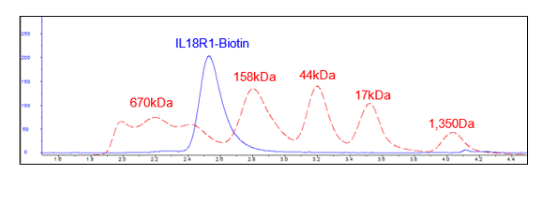IL18R1, Fc Fusion, Avi-Tag, Biotin-Labeled HiP™ Recombinant
Recombinant human IL18R1 (interleukin 18 receptor 1), encompassing amino acids 22-329. The C-terminus is fused with the Fc fragment of a human IgG1, followed by an Avi-tag™. This protein was affinity purified. HiP™ indicates a high purity protein (≥90% pure) and less than 10% aggregation as measured by gel filtration.
≥90%
Aqueous buffer solution.
8 mM phosphate, pH 7.4, 110 mM NaCl, 2.2 mM KCl, and 20% glycerol
This protein is enzymatically biotinylated using Avi-Tag™ technology. Biotinylation is confirmed to be ≥90%.
For more information on enzymatic biotinylation, please see our Tech Note.
IL18R1 (interleukin 18 receptor 1), also known as CD128a or IL18RA, is a member of the immunoglobulin superfamily. It binds specifically to IL-18, a pro-inflammatory cytokine, and can be found on CD8+ T cells. It is one of the two subunits of the IL-18 receptor, the other being IL18RB (also known as IL18RAP). IL18R1 is inducible and has low affinity per se for IL-18 but binding of IL-18 leads to the recruitment of the other subunit to form a high affinity complex and activate the NF-κB (nuclear factor kappa-light-chain enhancer of activated B cells) signaling pathway. Activation of the inflammasome leads to the cleavage of pro-IL-18 into its active form, linking the IL18/IL18R signaling axis to NLRP3 (NOD-, LRR-, pyrin domain containing protein 3) inflammasome and diseases such as CDK (chronic kidney disease). Overexpression of IL18R1 resulted in decrease of LUSC (lung squamous cell carcinoma) cell proliferation and migration. The role of this receptor and IL-18 in cancer and inflammation are still being uncovered and this understanding will open the door to new treatments.




